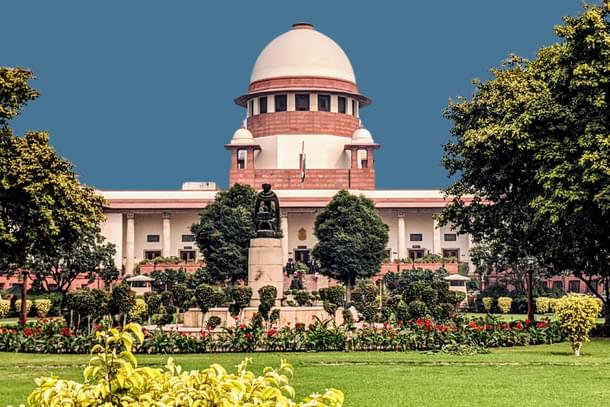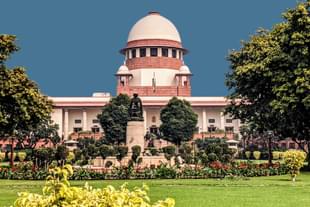Legal
Ten Years Since NJAC Verdict — Five Structural Fixes To Reform Indian Judiciary
Harsheeta Rai Sharma
Apr 18, 2025, 11:50 AM | Updated Apr 21, 2025, 12:33 PM IST
Save & read from anywhere!
Bookmark stories for easy access on any device or the Swarajya app.


The NJAC Judgement, pronounced in 2015, was a watershed moment for the Indian judiciary.
This is because, apart from the quashing of the National Judicial Appointments Commission (NJAC) by the Supreme Court, over 11,500 pages of suggestions were given by the Bar Council of India and the legal eagles of the country to improve the Indian justice space.
These 11,500 pages worth of views were compiled as a result of an order of the Court, reflecting a ‘hope’ that substantive changes would follow.
Fast forward to 2025—an unimaginable amount of half-burnt currency notes was found at the outhouse of Justice Yashwant Verma of the Delhi High Court. The video release of the incident has prompted serious questions about judicial accountability and transparency.
The case of Justice Nirmal Yadav from the Punjab and Haryana High Court has also come to light, wherein cash was dropped at the judge’s door in 2008.
On another note, the number of pending cases in the country has now crossed the 4.5 crore mark, and as of March 2025, one-third of the positions of judges in High Courts remain vacant.
In this backdrop, here are five practical tools of reform that may paint a better future picture for the judicial system of Bharat:
1. Rethinking Judicial Oversight
To investigate the Justice Yashwant Verma case, a 3-member panel has been constituted by the Chief Justice of India. It consists of Justice G.S. Sandhawalia, Chief Justice of Himachal Pradesh High Court; Justice Sheel Nagu, Chief Justice of Punjab and Haryana High Court; and Justice Anu Sivaraman of Karnataka High Court.
But rather than addressing individual cases by forming such committees from time to time, the process of addressing such complaints and allegations must be streamlined. This could happen when there is an independent, devoted body to investigate allegations of corruption or even misbehaviour.
In the recommendations given in the NJAC case, it was proposed that there should be a secretariat under the direct supervision of the CJI to carry out such investigations, at both the Supreme Court and the High Courts. But it could not be implemented.
The US has various Judicial Commissions for judicial oversight. The UK has a dedicated Judicial Conduct Investigations Office (JCIO) for this purpose. It is high time that such a body, commission, or committee be established in India as well, with branches in each state.
Whether the commission shall be supplemental to, or subordinate to, the Collegium is a matter of legislative discretion and judicial scrutiny.
2. Disclosure of Assets by Judges
When it comes to curbing corruption in the judiciary, regular and transparent disclosure of judges’ assets stands out as the gold standard. This principle was articulated in the 1997 Restatement of Values of Judicial Life.
But it has long languished as an ideal rather than a norm. The Supreme Court’s recent resolution on April 1, 2025, urging judges to declare their assets, is a welcome move—yet the road to true judicial accountability remains long and steep.
As of April 11, 2025, a mere 11.94% of sitting judges nationwide have publicly disclosed their assets. Among High Court judges, only 95 out of 762 (12.46%) have made such declarations.
Alarmingly, 18 High Courts—including major ones like Allahabad, Bombay, Calcutta, Gujarat, and Patna—have not published any asset details, highlighting a big transparency deficit in the higher judiciary.
Clearly, piecemeal measures won’t suffice. This uphill path will not end until there is a solid mandate for the judges of all levels of judiciary—District Courts, High Courts, and the Supreme Court—to regularly disclose their assets. Harnessing technology to facilitate and monitor these disclosures could be a game-changer, especially at the District Court level.
3. Protecting Whistleblowers in Judiciary
The fear of consequences upon reporting corrupt practices in the judiciary is no less than in public offices. The Whistle Blowers Protection Act, 2014 safeguards individuals who expose such corruption and misconduct in public offices, but its applicability to the judiciary, particularly in cases involving corruption by judges, remains ambiguous.
Hence, including judges and judicial officers within the ambit of the Whistleblowers Act is a much-needed reform. It will encourage individuals to come forward with information without fear of reprisal.
There must be an online complaints redressal system, with limited access, and an option to maintain anonymity.
4. Ad-hoc Judges
In his dissenting opinion within the NJAC judgment, Justice Chelameswar (the only dissenting judge on the 5-judge panel) highlighted the burgeoning backlog of cases in India's constitutional courts, which was “clearly not a certificate of efficiency”.
He suggested that judicial appointments were just one facet of the overhaul needed in the functioning of the Indian judiciary.
This concern is underscored by the staggering statistics: in 2015, when the NJAC verdict was delivered, 41.53 lakh cases were pending in High Courts. Instead of this pressure coming down, 20 lakh more cases have been added to the tally, making it 62 lakh pending cases as of January 25, 2025—a 50% surge in just 10 years.
Acknowledging this crisis, the Supreme Court issued guidelines on April 20, 2021, advocating the appointment of retired judges as ad-hoc judges in High Courts, under Article 224A of the Constitution.
Recently, on January 30, 2025, the Supreme Court amended these guidelines, directing each High Court to consider appointing between two and five ad-hoc judges, not exceeding 10% of the court's sanctioned strength. This measure would help dispose of cases by utilizing the wisdom of the retired judges.
But, to utter surprise, despite the Apex Court’s directives, the Union Government has not received any proposals from High Courts.
This flags the inertia that the higher judiciary is facing with regard to the appointment of ad-hoc judges—a task that is supposed to benefit them by dividing their workload. Hence, urgency has to be shown in fast-tracking such appointment procedures.
5. Expanding the Contours of the Collegium
Appointment of judges in the higher judiciary in India has been cloaked in the opacity of the collegium system.
The ‘Collegium’ consists of a body of the Chief Justice of India and four other seniormost judges of the Supreme Court, who collectively decide names to be appointed as the judges of the Supreme Court and even the High Courts. There is no transparency with regard to the appointment of judges, transfer of judges, and even evaluation of performance.
The only solution is to expand the boundaries of the collegium and make it ‘broad-based’. Jurisdictions like the UK stand as classic examples, where the Judicial Selection Commission has 15 members—a mixed bag of judges, lawyers, jurists, and political figures.
Similarly, in India, there must be such a commission that has representation from senior-most judges of the Supreme Court (obviously headed by the CJI), CJIs of High Courts, legal eagles, the Ministry of Law and Justice, and some jurists that could be nominated by the Leader of Opposition to strike a balance.
The size of the new collegium/commission must not be so large as to dilute the quality of judicial appointments, but should also not be too small so as to invite biases and nepotism.
Importantly, the Chairman of the Bar Council of India, who represents the faith of the legal community of India—presently 27 lakh strong—should also have a seat at the table. This move shall bring in an element of democracy within the judiciary.
When the collegium is broad-based, the probability of any biases or political pressures seeping in gets diminished. This is why expanding the collegium shall not hinder but further the goal of judicial independence.
Conclusively, as it is quoted, the citadel never falls except from within. Similarly, it is high time that robust and timely reform of the judicial system of India is undertaken, so that the citadel of justice, which the Indian judiciary is, can be saved.
Harsheeta Rai Sharma is a lawyer and works as a public policy consultant.





